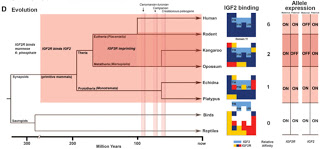An Exon Splice Enhancer Primes IGF2:IGF2R Binding Site Structure and Function Evolution
Christopher Williams,1* Hans-Jürgen Hoppe,2* Dellel Rezgui,2 Madeleine Strickland,1 Briony E. Forbes,3 Frank Grutzner,3 Susana Frago,2 Rosamund Z. Ellis,1 Pakorn Wattana-Amorn,1 Stuart N. Prince,2 Oliver J. Zaccheo,2 Catherine M. Nolan,4 Andrew J. Mungall,5 E. Yvonne Jones,6 Matthew P. Crump,1† A. Bassim Hassan2†
ABSTRACT
Placental development and genomic imprinting coevolved with parental conflict over resource distribution to mammalian offspring. The imprinted genes IGF2 and IGF2R code for the growth promoter insulin-like growth factor 2 (IGF2) and its inhibitor, mannose 6-phosphate (M6P)/IGF2 receptor (IGF2R), respectively. M6P/IGF2R of birds and fish do not recognize IGF2. In monotremes, which lack imprinting, IGF2 specifically bound M6P/IGF2R via a hydrophobic CD loop. We show that the DNA coding the CD loop in monotremes functions as an exon splice enhancer (ESE) and that structural evolution of binding site loops (AB, HI, FG) improved therian IGF2 affinity. We propose that ESE evolution led to the fortuitous acquisition of IGF2 binding by M6P/IGF2R that drew IGF2R into parental conflict; subsequent imprinting may then have accelerated affinity maturation.
COMMENT
This report published by Matthew Crump’s and Bassim Hassan’s groups this week in Science analyses the evolutionary molecular changes, which led to high affinity binding of IGF2R to IGF2 in mammals but not birds and reptiles. IGF2 and IGF2R are two of the roughly 100 canonically imprinted genes found in mammals, with IGF2 expressed only from the paternal allele and IGF2R only from the maternal allele. In mice, deletion of the maternal IGF2R gene results in overly large offspring while deletion of the paternal IGF2 gene results in dwarf offspring. In humans, only IGF2 is imprinted but not its receptor. Activation of the maternal IGF2 allele causes Beckwith-Wiedemann syndrome, which is characterized large body size at birth and an increased risk for childhood cancer. The reciprocal expression of IGF2 and IGF2R underscores the parental conflict over the distribution of resources to their offspring. This hypothesis is based on the theory that mothers want to distribute their resources equally to all their current and future offspring, while fathers favor the maternal investment into the current offspring.
This study correlates the appearance of IGF2/R with the occurrence of their monoallelic expression. Specifically, Williams et al. show that binding appeared in all primitive mammals, while imprinting is only found in theria, such as rodents, kangaroos and opossums. Therefore, the authors hypothesize that the evolution of IGF2/R imprinting was facilitated by the appearance of their molecular binding, which may conversely have accelerated the selection for improved regulation of IGF2 through IGF2R.
This report thoroughly reveals the structural changes that lead to IGF2:IGF2R complex formation but falls short on explaining the mechanism of how IGF2/R binding facilitates genomic imprinting of these two genes.

